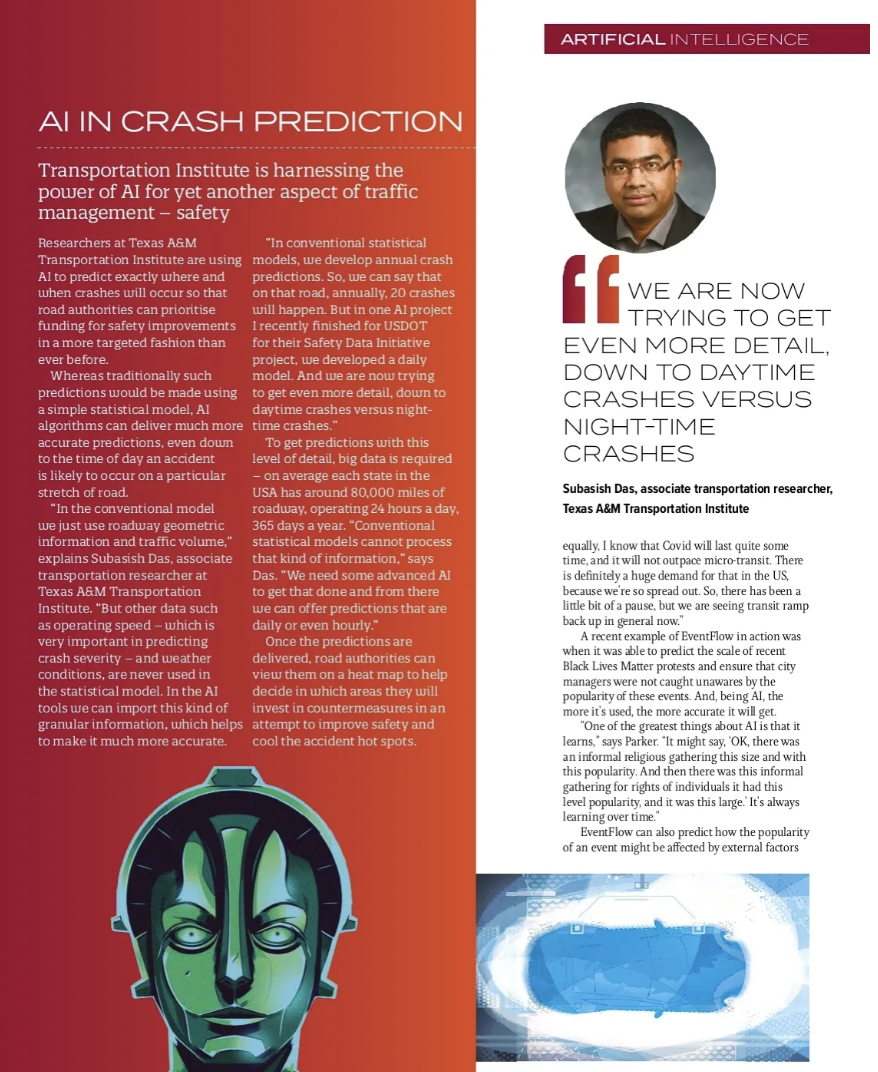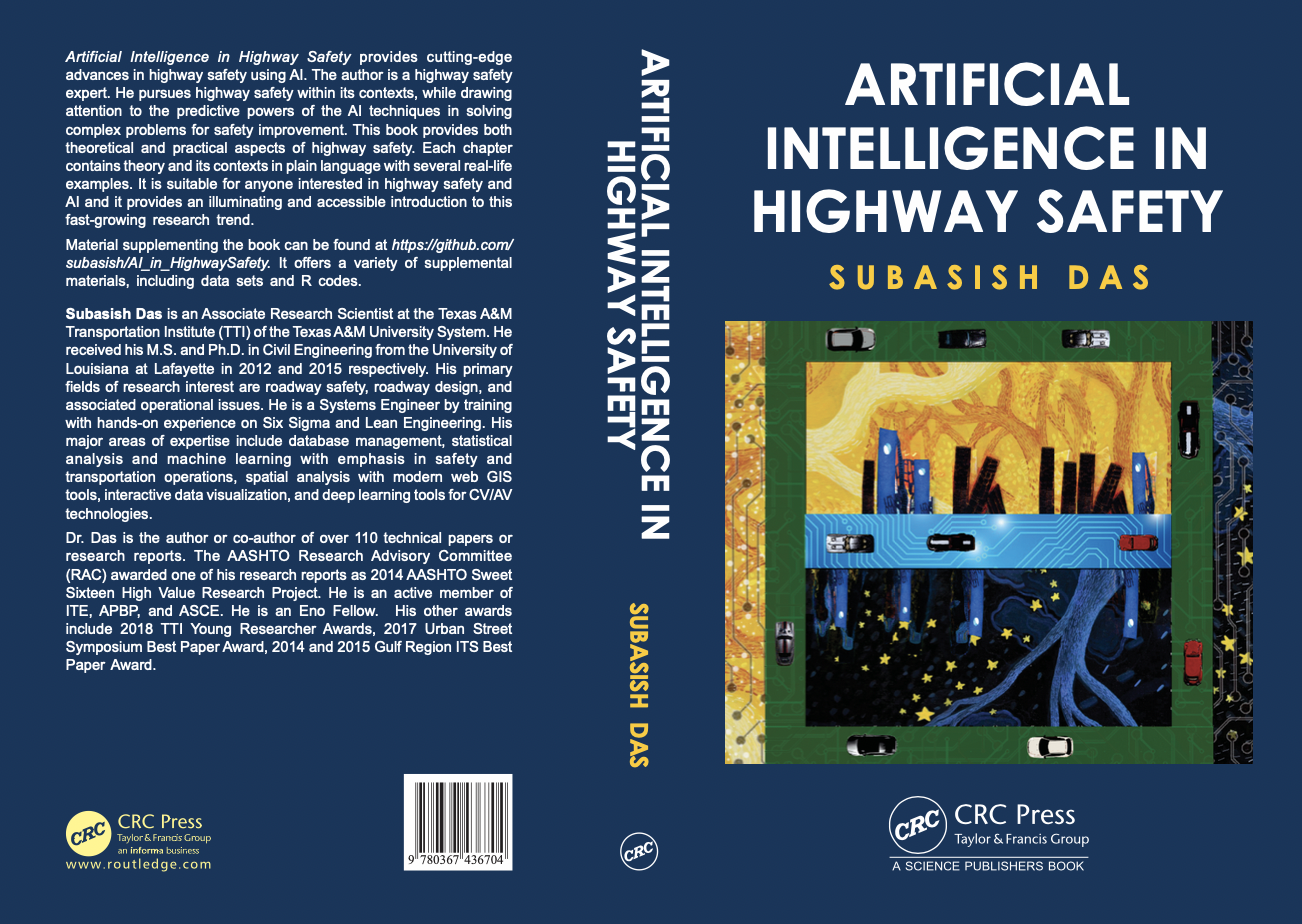About Subasish Das
I am Subasish. I grew up in Chattogram, Bangladesh. I am a tenure-track Assistant Professor of Civil Engineering program (Ingram School of Engineering) at Texas State University. Previously, I worked as an Associate Research Scientist at Texas A&M Transportation Institute (TTI) for almost 7 years. I am still affiliated with TTI as a part time employee. I have more than 13 years of experience related to roadway safety, traffic operation, and CAV technologies. I am a Systems Engineer by training with hands on experience on Six Sigma and Lean Engineering. My major areas of expertise include database management, statistical analysis and machine learning with emphasis in safety and transportation operations, spatial analysis with modern web GIS tools, computer programming (R, python, VBA, html, and javascript), interactive data visualization, and deep learning tools for CV/AV technologies.
I have published more than 120 technical reports, and journal articles. I am an active member of ITE, and ASCE. I am an Eno Fellow. I recently served as vice-president of membership of Young Professionals in Transportation Houston chapter.

Traffic Technology International: A Conversation with Subasish Das
Researchers at Texas A&M Transportation Institute are using AI to predict exactly where and when crashes will occur so that road authorities can prioritise funding for safety improvements in a more targeted fashion than ever before. Whereas traditionally such predictions would be made using a simple statistical model, AI algorithms can deliver much more accurate predictions, even down to the time of day an accident is likely to occur on a particular stretch of road. Traffic Technology International interviewed Subasish Das on this issue. This issue was featured in Texas Transportation International's September 2020 issue.
Q: Can AI algorithms deliver much more accurate predictions?

A: In the conventional model we just use roadway geometric information and traffic volume. But other data such as operating speed – which is very important in predicting crash severity – and weather conditions, are never used in the statistical model. In the AI tools we can import this kind of granular information, which helps us to make it much more accurate. In conventional statistical models, we develop annual crash predictions. So, we can say that on that road, annually, 20 crashes will happen. But in one AI project I recently finished for USDOT for their Safety Data Initiative project, we developed a daily model. And we are now trying to get even more detail, down to daytime crashes versus nighttime crashes.
Q: Why is there a need for AI model in highway safety analysis?
A: Conventional statistical models cannot process big data and data stream related problems. We need some advanced AI to get that done and from there we can offer predictions that are daily or even hourly. Once the predictions are delivered, road authorities can view them on a heat map to help decide in which areas they will invest in countermeasures in an attempt to improve safety and cool the accident hot spots.
Artificial Intelligence in Highway Safety: A New Text Book written by Subasish Das

Artificial Intelligence in Highway Safety provides cutting-edge advances in highway safety using AI. The author is a highway safety expert. He pursues highway safety within its contexts, while drawing attention to the predictive powers of the AI techniques in solving complex problems for safety improvement. This book provides both theoretical and practical aspects of highway safety. Each chapter contains theory and its contexts in plain language with several real-life examples. It is suitable for anyone interested in highway safety and AI and it provides an illuminating and accessible introduction to this fast-growing research trend. Material supplementing the book can be found at https://github.com/ subasish/AI_in_HighwaySafety. It offers a variety of supplemental materials, including data sets and R codes.
Research Grants
- May, 2022: Awarded TxDOT RTI Project 0-7144 Real-time Decision Support Tool for Urban Roadway Safety Improvement (Budget: $470,000, Role: PI)
- May, 2022: Awarded TxDOT RTI Project 0-7156 Using Vehicle Probe Data to Evaluate Speed Limits on Texas Highways (Budget: $400,000, Role: Co-PI)
- May, 2022: Awarded three other TxDOT RTI projects in which I will play researcher role. These projects are: 1) 0-7152 Estimating Latent Bicyclist and Pedestrian Demand for Shared Use Path Design 2) 0-7140 Improved Queue Warning System Combining Multiple Data Sources 3) 0-7136 Road Diet Guidelines for Texas
Sponsors
